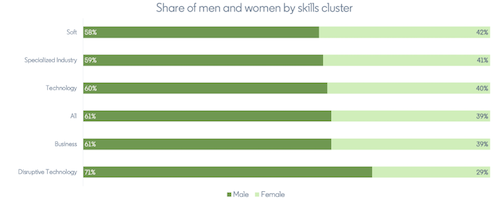Empowering Women through Education and Skills
As we close out Women’s History Month, I’ve been reflecting on educational experiences in my life. I come from a long line of women who value education. In the ‘90s, my sisters, my mother and I completed various bachelor’s and master’s programs in the same year. My mom earned a Bachelor of Fine Arts at the age of 50, after taking decades off to raise our family. My aunts also earned advanced degrees later in life -- one earned her Juris Doctorate at the age of 52 and another earned her Doctorate in Education at 59. These accomplishments proved to me there is no time limit on the pursuit of education.
My personal experiences and work at LinkedIn have fostered my interest in trends around women in relation to Higher Education and the workforce. In honor of Women’s History Month, I researched the latest shifts in these areas. The following insights focus on the continuous growth of women earning degrees, and how the degrees and skills they acquire or, in some cases lack, impact career opportunities. These insights may inspire your upcoming marketing and advertising plans and pave the way for higher female enrollment at your school.
Women Earn More Degrees Than Men
Since 2000, women have outnumbered men when it comes to college enrollment. In fact, for roughly four decades, women have accounted for the majority of college-educated adults in the U.S., peaking in 2019, with women making up a majority of the college-educated workforce.
The upswing is seen across the board in Higher Education. In addition to earning more bachelor’s degrees than men, a record number of women are attending business school. Women comprised 38.5% of B-school students in 2019 (up from 32% in 2011). And 19 schools report 40%+ for female full-time MBA enrollment. When we look at doctoral degrees, women outnumber men here, as well – and the trend is expected to continue.
Closing The Gap With Key Skill Sets
In spite of these strides in advanced education, women still lag when it comes to equal representation across jobs, which hurts women and companies. According to a report in Harvard Business Review, gender diversity can improve a company’s bottom line by 21%.
The answer may lie in the skill set women need to develop for the 21st century. A review of the Global Gender Gap Report from the World Economic Forum underscores the underrepresentation of women when it comes to new and disruptive technologies. The largest gaps between men and women are in emerging jobs driving the new economy, including Data and AI, Engineering, and Cloud Computing.
It’s no surprise Technology skills are critical in fulfilling emerging jobs. While nearly every emerging job requires basic Tech skills, almost half require disruptive technology skills around AI, Robotics, and Cloud Computing.
According to Sue Duke, Head of Global Public Policy at LinkedIn, “… investments should be made to increase the overall supply of women in the workforce with disruptive tech skills, either through traditional education pathways, or non-traditional reskilling and up-skilling efforts from educators, employers and public sector stakeholders.”
How Higher Ed Marketers Can Help Close the Gap
When determining how to attract more female applicants, consider experiences that impact how many women think about Higher Education. With more women delaying pregnancy until later years, a growing number of women pursuing advanced degrees are also parenting. Childcare may be an important factor while taking classes and doing schoolwork. In addition, a supportive environment may be important, as well as diverse curriculum and career opportunities upon degree completion. Consider which programs and skills training will provide the most job opportunities for women.
Here are several ways to align your marketing with a female audience:
- Engage female prospects through imagery. Messaging may be gender-neutral, or highlight programs and skill development specifically geared toward women (a Women’s Leadership Program, for example), but imagery should feature women. This will allow women to see themselves in your program.
- Highlight women at your university. When women evaluate Higher Ed options, they are naturally drawn to schools that value other women. Find ways to promote distinguished female faculty and accomplished alumni. In addition, tout programs dedicated to the new economy skill set, and wherever possible, show your current female student base.
- Promote relevant services and support. Does your school offer women’s groups and ally groups dedicated to helping women close the gender gap? Is there an office dedicated to Diversity, Inclusion and Equity? Highlight these along with parent support groups, daycare services, and flexible schedule options that make it easier to juggle work-life balance.
As you make plans to leverage areas of potential growth where women are underrepresented, take inspiration from Dr. Marie Gould Harper, Dean, School of Business at American Public University System:
“At the beginning of 2020, Forbes reported that women now hold more jobs than men in the United States workforce. We have much to celebrate, but we have not yet arrived. I believe two things need to occur. First, we have to keep the pipeline filled with qualified women to be a part of a succession plan when some of these women are ready to move on, and that will require ensuring that potential female candidates receive the necessary education to stay current with industry standards. Some of the essential skills identified by leading corporations include areas such as communication, problem solving, critical thinking and technical business skills. Second, we need mentoring programs and networks to provide these women with the support needed for leading a balanced life. APUS’ School of Business has several programs offering courses and degrees that can assist this population with obtaining and refreshing these skill sets.”
Ready to tap into the many opportunities we’ve shared here? Get in touch with the LinkedIn Marketing Solutions team to activate your marketing strategy!






